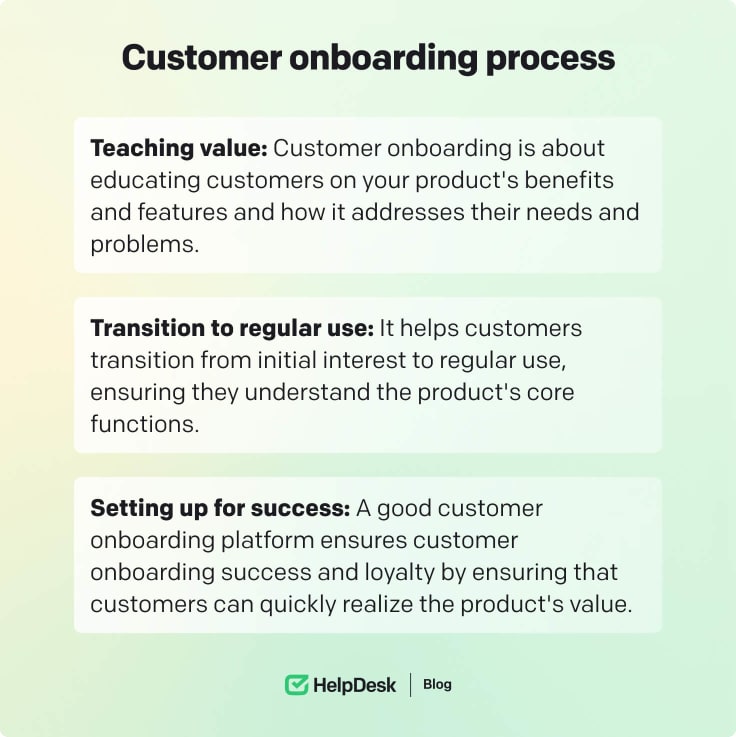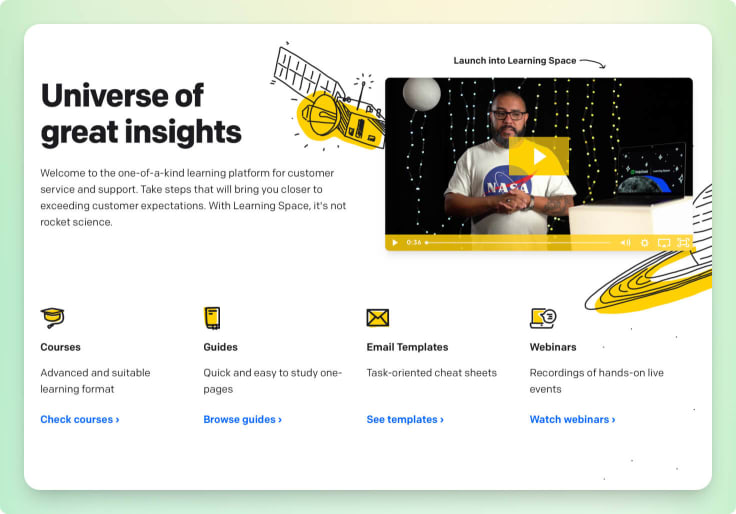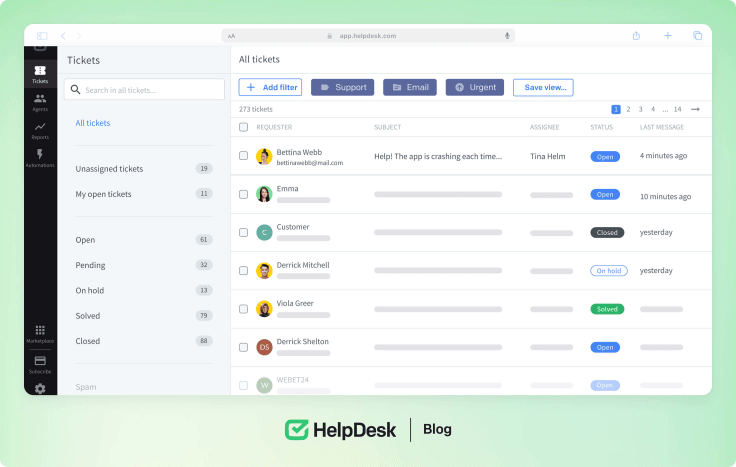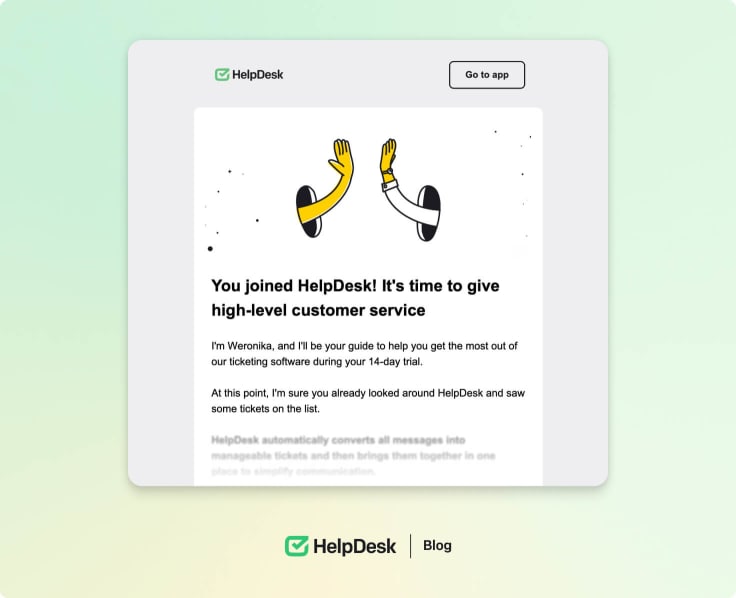Customer onboarding is a big part of the customer journey. It directly shapes how customers view your product or service and lays the groundwork for a robust and lasting relationship. An expert onboarding process educates customers on product usage and showcases its value, resulting in heightened satisfaction and long-term retention.
Throughout this comprehensive guide, we’ll explore the fundamental elements of a successful customer onboarding approach, covering vital steps, strategic planning, and optimal techniques for ongoing enhancement.
Let’s embark on this journey to create exceptional customer experiences together!
What is customer onboarding?
Customer onboarding is a process that establishes the groundwork for a significant relationship between your clients and your company. It involves guiding new customers through each step, ensuring they feel confident and satisfied with your product or service.
From the moment they join you, you should be dedicated to providing the support and resources they need to become experts and enthusiasts.
You have to understand that building trust and loyalty begins right here. This phase is where you can demonstrate your reliability and organizational skills. Embracing customer onboarding means laying the groundwork for intense, long-lasting connections.

Benefits of an effective customer onboarding process
A good onboarding process is a cornerstone of customer experience, and it has multiple benefits when it is done well:
-
Personalized experience: It allows companies to tailor customer onboarding based on their unique needs, preferences, and goals. This personalization can increase customer engagement and satisfaction.
-
Reduced customer churn: Proper customer onboarding minimizes the likelihood of customers abandoning the product, as they feel more comfortable and capable of using it. The easier your product is to understand, the better the client retention.
-
Enhanced engagement: Engaged customers are more likely to explore additional features, provide valuable feedback, and become advocates for the product. Onboarding is beneficial not only for the customers but also for the company.
Give your customers the best support you can with the HelpDesk ticketing system. 🤝 Join our free 14-day trial and discover how we can improve your customer journey. 🚀
The customer onboarding checklist
Follow these onboarding tasks for a seamless start to your customer’s onboarding journey.
Step 1: Make the sign-up process effortless
The onboarding journey begins with the sign-up process, which should be as straightforward and user-friendly as possible.
-
Minimize friction: Use minimal forms during sign-up and data collection to reduce repetitive or unnecessary information and prevent potential customers from losing interest. Only ask for the most critical information.
-
Clear instructions and feedback: Provide clear and concise instructions and immediate feedback during sign-up, ensuring users understand each step and any requirements. A confirmation email once the customer has successfully signed up will ease confusion and provide structure from the beginning.

Step 2: Say “Hello” with a welcome email
A well-crafted welcome email sets the tone for the customer’s journey and can effectively encourage and guide them to the next steps.
-
Warm and personal greeting: Start with a friendly greeting and a thank you for choosing your product. This makes the customer feel appreciated and welcomed.
-
Introduction to critical features: Highlight the main features and benefits of the product, providing a brief overview of what the customer can expect.
-
Next steps and resources: To help customers get started, include links to critical resources such as tutorials, FAQs, and customer support options. Provide contact information so clients know that assistance is always available.

Step 3: Be ready for the first impression
A customer’s first real interaction with your product, such as their first login, is critical for forming their initial impression.
-
Guided onboarding tours: Implement guided tours or tooltips that walk customers through the product’s main features and functionalities, helping them get started without feeling overwhelmed.
-
Personalized welcome messages: Use customized messages from the team or the CEO to make the experience more engaging and human. Putting a face to the company will help clients remember your mission and goals.
Step 4: Provide a learning experience
A comprehensive learning experience ensures customers understand how to effectively use the product.
-
Interactive tutorials: Provide interactive tutorials or walkthroughs that guide users through tasks and features. This hands-on approach helps reinforce learning and confidence. This step will help the customer engage with the services offered and learn more about the company.
-
Resource library: Maintain an extensive resource library, including videos, articles, and detailed guides, to support customers at every stage of their journey.
Discover more potential in your customer support with the HelpDesk Learning Space. Check out our latest lesson now! 🧑🚀

Step 5: Don’t forget to follow up
Ongoing communication is key to customer loyalty, maintaining engagement, and ensuring that customers continue to derive value from the product.
-
Periodic check-ins: Schedule regular check-in emails to provide tips, share best practices, and highlight new features.
-
Encourage feedback: Actively seek customer feedback to understand their experience and identify areas for improvement.
Explore more about the importance of follow-up messages. 🚀 Read our lesson in the HelpDesk Learning Space. 📚

Onboarding strategy and planning
With a thoughtful strategy and meticulous planning, we’ll outline all the essential elements for a successful onboarding program. Ensure you meet customer needs and achieve your business goals.
Deciding who will own the customer onboarding platform
The success of the entire onboarding process requires clear ownership and accountability. Specific roles and responsibilities must be assigned to cover every step of the onboarding journey.
-
Cross-departmental collaboration: Onboarding is a multifaceted process that often requires input from various departments, including marketing, sales, account managers, and customer support. Each department offers unique insights that can enhance customer onboarding. For example, the marketing team can provide valuable data on customer expectations, while the sales team can offer technical insights to streamline products. Working together across different departments will build a seamless onboarding experience.
-
Dedicated onboarding specialist: Hiring dedicated onboarding specialists or customer success managers can significantly enhance customer onboarding. These professionals focus on helping new customers navigate the initial stages of using a product, offering personalized guidance and support. They’re crucial in ensuring customers understand how to use the product and recognize its value and potential benefits.
-
Defining roles and responsibilities: It’s important to clearly define the roles and responsibilities of each team member involved in managing customer onboarding. This includes assigning who will create and update onboarding materials, conduct training sessions, and handle customer inquiries and issues during onboarding. Clear division of tasks helps prevent overlaps and gaps in the onboarding journey, ensuring a smooth and efficient process.
Identifying your program’s goals
Establishing clear, measurable goals for your onboarding program is necessary for evaluating its success.
-
Setting success metrics: Define specific metrics to assess the success of your onboarding program. Key metrics include time to first value, the time it takes for a customer to experience the product’s core value, user activation rates, which provide a percentage of users who complete key onboarding milestones, and customer satisfaction scores. These metrics provide quantitative data that can be used to refine and improve the onboarding process.
-
Aligning with business objectives: Ensure the onboarding program’s goals align with the broader business objectives. The company’s mission, vision, and values should always be clear during customer onboarding.
-
Customer-centric goals: While business objectives are important, the primary focus of onboarding should be the customer. Goals should include improving customer satisfaction, reducing the time required to achieve their desired outcomes, and increasing overall engagement with the product. A customer-centric approach ensures that the customer onboarding process meets the needs and expectations of the user, which in turn drives business success.
Determining how customer onboarding will take place
The onboarding method will depend on your product’s complexity and your customer base’s specific needs.
-
Self-service model: A self-service model can be highly effective for products with relatively straightforward functionality. This model typically includes a comprehensive resource library with documentation, tutorials, and FAQs that customers can access at their own pace. The self-service model is cost-effective, making it an excellent choice for companies with a large customer base.
-
Personalized onboarding: For more complex products, personalized onboarding sessions may be necessary. This could involve one-on-one training with a customer success manager, personalized email sequences, or interactive webinars. Personalized onboarding helps ensure that customers fully understand the product and how to use it effectively, which is particularly important for products with a steep learning curve.
-
Blended approach: A blended approach that combines self-service resources with personalized support can offer the best of both worlds. Customers can access basic information and tutorials through the self-service portal, while customized support is available for more complex issues or questions.
Creating a review system to continually improve customer onboarding
An effective onboarding program is always dynamic; it requires continuous review and improvement.
-
Feedback collection: Regularly collect feedback from customers to gauge their onboarding experience. This can be done through surveys, direct interviews, or feedback forms integrated into the onboarding process. Feedback should be collected at various stages of the onboarding journey to capture a comprehensive view of the customer experience.
-
Analyzing feedback and data: Use the feedback and data collected to identify patterns and areas for improvement. Positive feedback can also highlight what works well and should be maintained or expanded.
-
Internal review and adjustment: In addition to customer feedback, internal reviews should be conducted to assess the effectiveness of the onboarding process. This involves regular meetings with key stakeholders, including onboarding specialists, customer support, and product teams, to discuss feedback, performance metrics, and potential improvements. Based on onboarding input and internal assessments, adjustments should be made to continually enhance customer onboarding.

Being prepared for change
Customers’ needs and expectations evolve, and your onboarding process should be flexible enough to adapt.
-
Flexibility: Design the customer onboarding process to accommodate growth in the customer base or expansions in product offerings. It might involve creating modular training materials that can be easily updated or expanded and technology solutions like learning management systems (LMS) that can handle increased traffic and data.
-
Continuous learning and adaptation: Stay informed about industry trends and best practices in customer onboarding. Continuously incorporating new insights and innovations into the customer onboarding process ensures it remains relevant and practical.
-
Proactive approach: Anticipate customer needs and market condition changes and update the onboarding process accordingly.
Best practices for customer onboarding
An excellent onboarding ensures new customers have a smooth and successful introduction to your product or service. Following the recommended best practices can enhance the customer experience and set the stage for long-term satisfaction and retention.
Here’s how to optimize your onboarding process:
Directly address customer support
As new customers start using your product, they will likely encounter questions or challenges that require support beyond what your customer success team can provide. It is important to anticipate these needs and offer multiple support options to address them effectively.
-
Multiple support channels: Ensure your customer support strategy includes various channels such as AI chatbots, help desk systems, live chat, and email support. AI chatbots can handle common queries and provide instant responses, while help desk systems can manage more complex issues and track ticket statuses. Live chat and email support should be available for customers who need personalized assistance. Offering a range of support options ensures customers can choose the best method that suits their needs and preferences.
-
Clear support objectives: Set clear goals for your customer support team to ensure they’re prepared to handle the diverse needs of new customers. Objectives should include timely responses, efficient issue resolution, and helpful guidance. Regularly review support metrics to assess performance and identify areas for improvement.
-
Proactive support: Besides reactive support, consider implementing proactive measures such as contacting customers with tips and best practices based on their usage patterns. Proactive support helps prevent issues before they arise and demonstrates your commitment to customer success.
Provide the best customer support. Join HelpDesk and try its free 14-day trial. 🚀

Build a knowledge base
Well-organized customer onboarding is valuable for customers who prefer to find solutions independently. It should be comprehensive and easily accessible, providing customers with the information they need to troubleshoot issues.
-
Comprehensive content: Develop a knowledge base that includes a wide range of content, such as articles, FAQs, how-to guides, video tutorials, and troubleshooting tips. Ensure that the content is clear, concise, and relevant to the common issues and questions that customers may encounter. Regularly update the knowledge base to reflect new features, updates, and customer feedback.
-
Easy navigation: Design the knowledge base with user experience in mind. Organize content into intuitive categories and provide a search function to help customers quickly find the necessary information. Use clear headings, bullet points, and visuals to make the content easy to read and understand.
-
Integration with onboarding: Integrate the knowledge base into customer onboarding by referencing relevant articles and resources in your onboarding materials. Encourage new customers to explore the knowledge base through onboarding, helping them become familiar with the available resources.

Set clear expectations
Setting clear expectations helps customers understand what to expect from your product and the onboarding process.
-
Transparent sales process: During sales, provide potential customers with a clear overview of what they can expect from your product. Highlight key features and benefits for using the product effectively.
-
Onboarding reiteration: Reinforce the value of your product during the onboarding process. Communicate how the product addresses the customer’s specific pain points and delivers on the promises made during sales.
Show value
To build excitement and for customers to see the value of your product, it’s important to re-emphasize its benefits and provide personalized examples of how it addresses their unique needs.
-
Highlight specific benefits: Articulate how your product will address the customer’s pain points and provide value. Use real-life examples or testimonials to demonstrate how other customers have successfully used the product to achieve their goals. Tailoring the messaging to the customer’s unique situation helps them see the direct benefits.
-
Personalized touch: Personalize the onboarding process by addressing customers by name and referencing their goals. It helps build rapport and makes customers feel valued. Consider using personalized onboarding materials, such as custom training sessions or tailored documentation, to enhance the experience.
-
Kickoff calls and specialized training: Offer kickoff calls or specialized training sessions to provide a more in-depth introduction to your product. During these sessions, discuss the customer’s specific needs and demonstrate how the product can meet those needs.
Customer onboarding examples
To understand the impact of effective customer onboarding, it is helpful to look at how leading companies implement their strategies. Here are real-world examples from HelpDesk, Grammarly, Slack, and Canva, showcasing different approaches and their benefits.
HelpDesk
HelpDesk offers a comprehensive product tour to new users, which is a key element of their onboarding strategy. The product tour covers each aspect of HelpDesk, including the following:
-
Ticket management: HelpDesk logs, tracks, and prioritizes customer cases. Each customer inquiry or problem is assigned a unique ticket, making it easier to manage and resolve.
-
Issue resolution: HelpDesk facilitates the resolution of customer cases by providing a platform for support agents to communicate with customers, troubleshoot issues, and offer solutions.
-
Asynchronous communication: HelpDesk enables communication between support agents and customers through various channels, such as email, chat, contact form, or social media. This helps clarify doubts, provide updates, and maintain a transparent line of communication.
-
Effortless automation: Automation and AI-based features help streamline repetitive tasks, route tickets to the appropriate departments, and provide quick responses to common queries, improving the efficiency of support operations.
-
Feedback collection: Customer feedback is a key to understanding their needs and improving products or services. HelpDesk includes features for collecting and analyzing customer feedback.
-
Proactive outreach: Customer success teams can use HelpDesk to proactively reach out to customers, offer assistance, and ensure they’re maximizing the value of the product/service.
HelpDesk guides users through these elements to ensure new customers are calm and can confidently start using the product. The interactive nature of the tour allows users to explore features at their own pace, making new customer onboarding engaging and educational.
Experience the perfect customer onboarding with HelpDesk. 🤝 Join our tool for a free 14-day trial. 👏

Grammarly
Grammarly adopts a personalized approach to customer onboarding by utilizing a quick survey to tailor the user experience. When new customers sign up, they’re asked to complete a brief survey that collects information about their writing goals, preferences, and focus areas.
The survey assists Grammarly in customizing the user experience by suggesting relevant features and providing personalized writing suggestions.
Slack
Slack is renowned for its highly personalized and interactive onboarding process. New users are welcomed with interactive tutorials introducing them to the platform’s core functionalities, such as creating channels, sending messages, and integrating apps.
Slack’s onboarding experience is designed to be engaging and dynamic. It features real-time prompts and interactive elements that guide users through their initial setup.
Canva
Canva offers an interactive and engaging onboarding process. It focuses on helping new users quickly understand how to use the platform for their design needs.
Upon signing up, users are guided through an interactive tutorial that covers key features such as creating designs, using templates, and accessing design elements.
Summary
Ensuring a successful customer onboarding process is crucial for setting the stage for a positive experience with your product or service.
Look at how HelpDesk, Grammarly, Slack, and Canva have used unique approaches to enhance customer engagement and support. These real-world examples highlight the significance of crafting an onboarding experience that is not only informative but also captivating, utilizing techniques like interactive tours, personalized surveys, dynamic tutorials, and hands-on exercises.
These proven strategies can minimize customer turnover, pave the way for sustained success, and nurture strong customer relationships. Embracing such best practices will undoubtedly increase customer satisfaction and customer loyalty.





